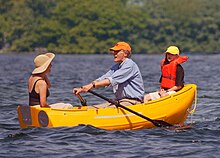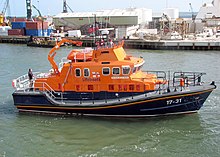Watercraft
Appearance


A watercraft or waterborne vessel is any
.Types
Watercraft can be grouped into surface vessels, which include ships,
paddleboards;[2] underwater vessels, which include submarines, submersibles, unmanned underwater vehicles (UUVs), wet subs and diver propulsion vehicles; and amphibious vehicles, which include hovercraft, car boats, amphibious ATVs and seaplanes
. Many of these watercraft have a variety of subcategories and are used for different needs and applications.
Design
The design of watercraft requires a tradeoff among internal capacity (
computer modeling and ship model basin testing before construction.[3]
Propulsion

Watercraft propulsion can be divided into five categories.
- Water power is used by drifting with a river current or a tidal stream. An anchor or weight may be lowered to provide enough drudging) or paddles or poles might be used to keep position.
- Human effort is used through a pole pushing against the bottom of shallow water, or paddles or oars operating in the surface of the water.
- Wind power is used by sails
- Towing is used, either from the land, such as the bank of a draught animals, humans or machinery, or one watercraft may tow another.
- Mechanical propulsion uses a motor whose power is derived from burning a fuel or stored energy such as batteries. This power is commonly converted into propulsion by propellers or by water jets, with paddle wheels being a largely historical method.[4]: 33
Any one watercraft might use more than one of these methods at different times or in conjunction with each other. For instance, early steamships often set sails to work alongside the engine power. Before steam tugs became common, sailing vessels would
back and fill their sails to maintain a good position in a tidal stream while drifting with the tide in or out of a river. In a modern yacht, motor-sailing – travelling under the power of both sails and engine – is a common method of making progress, if only in and out of harbour.[4]: 33–34 [5]: 199–202 [6]
See also
- Glossary of nautical terms
- Maritime history
- Ship transport
- Waterway
References
- ISBN 9781473825598.)
{{cite book}}: CS1 maint: location missing publisher (link - ISBN 978-1-4729-0105-7.
- ^ Tupper, Eric (1996). Introduction to Naval Architecture. Oxford, England: Butterworth-Heinemann.
- ^ ISBN 9781781593929.
- ISBN 978-1-8448-6309-9.
- ^ "Glossary of Nautical Terms M". Practical Boat Owner. 11 November 2014.
External links
Look up watercraft or vessel in Wiktionary, the free dictionary.
Wikimedia Commons has media related to Watercraft.
